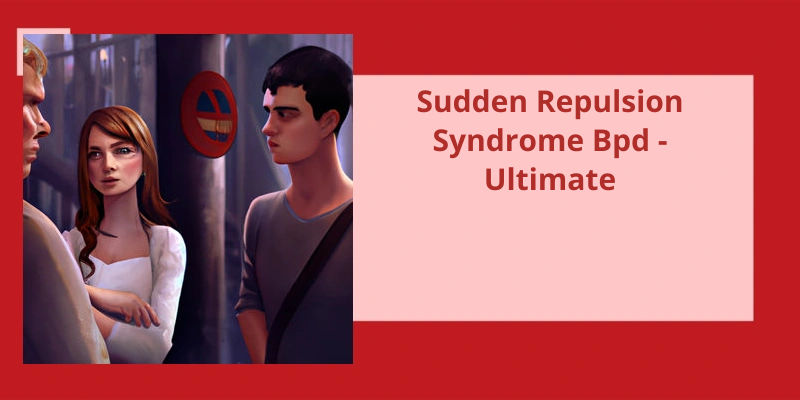This syndrome is characterized by an abrupt and intense aversion or repulsion towards someone, typically a close friend or romantic partner, whom the individual with BPD had previously idolized or held in high regard. The sudden shift from extreme attachment to sudden repulsion can be baffling and distressing, both for the person experiencing it and those around them. While SRS isn’t exclusive to individuals with BPD, it’s connection to the disorder adds an additional layer of complexity to understanding it’s origins and implications. This article aims to explore the various facets of Sudden Repulsion Syndrome in the context of BPD, shedding light on the potential causes, psychological mechanisms, and therapeutic approaches that can help individuals navigate this challenging experience.
Why Do I Get Sudden Repulsion Syndrome?
#2 Another possible explanation for sudden repulsion syndrome could be linked to fear of intimacy. As the relationship progresses and becomes more serious, our subconscious defenses may kick in to protect us from potential emotional harm. This instinctual reaction can manifest as sudden repulsion towards our partner, creating distance and allowing us to maintain a sense of control.
#3 In some cases, sudden repulsion syndrome may be an indication of unresolved past traumas or emotional wounds. These unhealed wounds can resurface when we become vulnerable in a relationship, triggering feelings of fear, anxiety, and repulsion as a defense mechanism to avoid further pain.
#4 It’s also important to consider personal insecurities and self-esteem issues as potential contributors to sudden repulsion syndrome. When we start to get close to someone, we may begin to question their motives or whether were truly deserving of their love and affection. These self-doubts can manifest as repulsion, as we might believe that it’s safer to push them away rather than risk being hurt or rejected.
Understanding these potential factors can help us navigate our emotions and communicate openly with our partner, thus fostering healthier and more fulfilling relationships. It’s important to seek professional help if these feelings persist or significantly impact our well-being.
#5 Another Possible Explanation for Sudden Repulsion Syndrome Could Be Related to Compatibility Issues. As We Spend More Time With Our Partner, We May Become Aware of Differences in Values, Interests, or Goals That Were Not Initially Apparent. These Differences Can Lead to Feelings of Repulsion as We Realize That We May Not Be as Compatible as We Initially Thought.
Another possible explanation for sudden repulsion syndrome could be related to compatibility issues. As we spend more time with our partner, we may become aware of differences in values, interests, or goals that weren’t initially apparent. These differences can lead to feelings of repulsion as we realize that we may not be as compatible as we initially thought.
This push/pull behavior often takes a toll on both the individual with BPD and those around them, leading to a cycle of love and rejection. Understanding why people with BPD push others away can shed light on the complexities of their condition and pave the way for compassion and support. In this article, we will explore the underlying reasons behind this behavior and discuss ways to navigate relationships with individuals with BPD.
Do People With BPD Push Others Away?
Do people with BPD push others away? The answer is yes. Push/pull behaviors are highly prevalent in individuals with Borderline Personality Disorder (BPD). This pattern involves pulling someone into a close relationship and then constantly pushing them away, creating a confusing dynamic. The person on the receiving end may find themselves uncertain about where they stand in the relationship, as their loved ones emotions and actions fluctuate rapidly.
Sudden Repulsion Syndrome, a term often associated with BPD, further exemplifies this behavior. The syndrome manifests as an intense, overpowering feeling of repulsion towards someone once perceived as close and trusted. Individuals with BPD may suddenly experience drastic shifts in their perception of others, distancing themselves from those they were once deeply attached to. This can be incredibly distressing for both parties involved, as the person with BPD struggles to comprehend their own conflicting emotions.
It’s important to note that these patterns aren’t intentional, as individuals with BPD often feel overwhelmed by their emotions and have limited control over their actions. They may be genuinely torn between wanting closeness and fearing rejection, trapped in a perpetual cycle of emotional turmoil.
By educating ourselves about BPD and the challenges it brings, we can contribute to a more compassionate and inclusive society, where those with BPD are understood rather than stigmatized.
Source: BPD Symptoms: Recognizing the Signs of BPD in Young Adults
Sudden Repulsion Syndrome, also known as SRS, is a peculiar phenomenon that perplexes many individuals in the realm of dating. Often occurring after a brief period of time, this mysterious condition manifests as a sudden aversion to the physical appearance of someone previously found amiable. While the individual might possess qualities of politeness, kindness, and overall pleasantness, inexplicably, a wave of repulsion engulfs our senses, leaving us questioning this bewildering transformation.
What Is the Sudden Repulsion Syndrome?
Sudden Repulsion Syndrome, also known as SRS, is a phenomenon that many individuals may encounter after engaging in a short-term romantic relationship. Urban Dictionary characterizes it as a condition where one feels a sudden wave of disgust towards their partners physical appearance, despite initially finding them attractive. This syndrome can manifest in varying degrees of intensity, causing genuine repulsion towards the individual in question.
When affected by SRS, the person experiencing it may feel perplexed by their sudden change of sentiments towards their partners appearance. It’s essential to recognize that SRS isn’t a reflection of the partners inherent flaws, but rather a manifestation of an internalized emotional reaction. This reaction can be rooted in deep-seated insecurities, fears, or unresolved emotional trauma within the individual.
It’s important to note that SRS can be more commonly observed in individuals with Borderline Personality Disorder (BPD). BPD is a mental health disorder characterized by unstable emotions, self-image, and relationships. Those with BPD often experience intense and rapidly shifting emotions, making them particularly susceptible to sudden changes in attraction and repulsion.
The triggers for SRS can vary from person to person and may not always be immediately apparent. For some individuals, it may be connected to unresolved childhood traumas or abandonment issues. Others may experience SRS as a defense mechanism, a way to distance themselves emotionally from the relationship to avoid potential hurt or rejection.
Coping with SRS can be challenging, both for the individual experiencing it and their partner. Open and honest communication is vital in navigating this syndrome effectively. Seeking professional help from a therapist or counselor can also provide valuable insights and strategies to address the underlying causes of SRS and develop healthier patterns of emotional regulation and relationship dynamics.
Conclusion
The manifestations of SRS vary greatly, but common triggers appear to involve threats to personal identity, fears of abandonment, and perceived rejection. Additionally, future studies should aim to elucidate the underlying mechanisms and explore potential interventions that could alleviate the distressing symptoms associated with SRS. By delving deeper into this phenomenon, we can hope to offer improved support and intervention for individuals with BPD, ultimately enhancing their overall quality of life.






